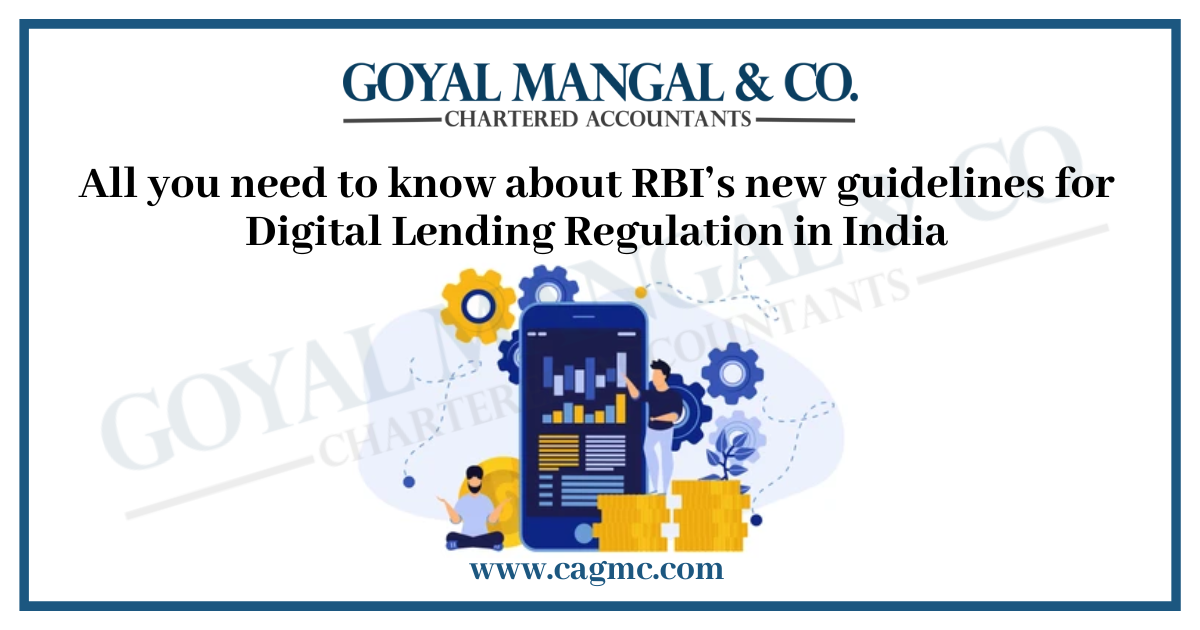
In the last decade, India’s Digital Lending Industry has grown exponentially, which allow consumers to borrow money from peer-to-peer lenders. However, the industry has largely been unregulated, which has resulted in unchecked third-party participation, misspelling, data privacy violations, unethical recovery techniques, and high interest rates. In this Blog we will have a view about the meaning of Digital Lending along with its regulations. This article briefly describes the Digital Lending Guidelines, Which category of Digital Lenders has to comply with the new framework?
|
Table of Content |
Meaning of Digital Lending
The use of technology and digital platforms to provide financial services, notably loans, to customers is referred as digital lending. Online lending platforms, mobile apps, and other digital channels are examples of this. Paytm, Lending kart, and Paisabazaar are three of India’s biggest digital lending services.
The Indian government has promoted digital lending to boost financial inclusion and credit access for underprivileged groups. Aside from that, digital lending platforms are fostering healthy competition in the lending market, which helps to lower interest rates for borrowers and improve risk management by analysing borrowers’ creditworthiness using advanced technologies such as big data, AI, and machine learning.
This can help to reduce the risk of loan defaults and improve the overall efficiency of the lending market. In recent years, digital lending in India has risen significantly, with many new firms entering the market and conventional financial institutions utilizing digital lending platforms.
Short note on Digital Lender
There are three kinds of digital lender, which are categorized by the Reserve Bank of India (RBI):
- Organzations which are lending as per the provisions of any regulatory body or statutory.
- Organizations those are allowed to carry out business on lending, and governed by RBI.
- Organizations are authorized by other regulatory or statutory provisions for lending business, but not governed by the RBI.
Which category of Digital Lenders has to comply with the new regulatory framework?
The new regulatory framework is mainly focused on two digital lending of Legal Service Providers (LSPs) and RBI’s Regulated Entities (REs). These are involved by them to increase several allowable credit facilitation services.
For organizations are authorized by other regulatory or statutory provisions for lending business, but not governed by the RBI. The rules and regulations are accurately enacting and formulating by the concerned regulators. Those are on digital lending as per recommendations of the RBI’s Working Group.
In case of unregulated organizations, the Working Group has provided association’s interventions and specific legislatives by the Central Government to check the illegal lending work being done by such organizations.
Need for Regulation in Digital Lending
Digital lending is a way of issuing and collecting loans using online platforms or mobile applications, allowing for speedy loan distribution while saving a significant amount of money that would otherwise be spent in the traditional lending business.
In India, there have been numerous reports of unethical loan practices. These activities include high interest rates, hidden fees, and aggressive marketing tactics, unlawful access to personal data, and harassment and intimidation. Exorbitant interest rates are charged by some lenders, making it impossible for borrowers to repay their loans. Others may fail to disclose all loan fees and charges, making it impossible for borrowers to compare alternative loan products. Some lenders utilize aggressive marketing strategies to attract consumers, while others have been accused of improperly accessing borrowers’ personal information.
In extreme circumstances, digital lenders have used harassment and intimidation to recover their loans, making it difficult for borrowers to handle the situation. As a result, that is why there was a significant demand for regulation in this market, which eventually came itself in the shape of RBI rules.
Reserve Bank of India guideline on Digital Lending
On September 20, 2022, the Reserve Bank of India (RBI) announced guidelines on digital lending to promote responsible lending practices and protect borrowers. The RBI has attempted to regulate the digital lending business through Regulated Entities (RE), which frequently creates alliances with various digital lending platforms to facilitate online lending, in these recommendations.
- The underlying principle of the Digital Lending Guidelines is that a Lending Service Provider should not be involved in the handling of funds flowing from the lender to the borrower or vice versa,” the RBI stated.
- The RBI clarified that “at the time of loan sanction, the borrower may be conveyed the name of empanelled agents authorized to contact the borrower in case of loan default,” and that “if the loan becomes delinquent and the recovery agent assigned to the borrower, the particulars of such recovery agent assigned must be communicated to the borrower through email/SMS before the recovery agent contacts the borrower for recovery.”
- The RBI stated that the whole loan life cycle (client acquisition, credit assessment, loan approval, disbursement, recovery, and associated customer support) does not have to be done digitally for the transaction to be classified as digital lending.
- In response to an inquiry about “whether the Guidelines are also applicable for corporate including MSME loans,” the RBI said the recommendations apply to any transactions that fulfil the definition of digital lending.
- The RBI has recently stated that “only those LSPs that interact with borrowers would be required to appoint a nodal Grievance Redressal Officer.”
- Credit card EMIs would not be covered by the digital lending rules because they are already covered by the Master Direction on Credit Card and Debit Card – Issuance and Conduct, 2022, according to the RBI. Other loan products offered on credit cards that are not regulated by these guidelines, on the other hand, fall under the digital lending guidelines, as do all loans offered on debit cards, including EMI programs.
- The recommendations say that the total cost of digital loans, expressed as an Annual Percentage Rate (APR), should be given to borrowers upfront. “In the case of floating-rate loans, the APR may be disclosed at the time of origination based on the prevailing rate in accordance with the KFS (Key Fact Statement) format.”
- Because the guidelines require repayments to be deposited directly into the lender’s bank account, one of the questions was how recovery agents could then collect cash from delinquent loan borrowers. “In the event of a delinquent loan, REs can use physical interface to recover loans in cash, if absolutely necessary.”
- In scenarios when a loan has been disbursed directly to the borrower’s bank account, but the repayment is from the corporate employer, who deducts the EMI amount from the borrower’s pay check, such repayments do not need to come directly from the borrower’s bank account, as necessary in other cases.
- The RBI stated that not all credit intermediation service providers linked with a regulated organization will be designated LSPs. The term “LSP” refers only to service providers who engage in digital lending transactions.
- Insurance charges must be included in the calculation of APR “only for the insurance which is linked/integrated in loan products as these charges are intrinsic to the nature of such digital loans,” according to the RBI.
- The RBI simply responded “No” in response to an inquiry about “whether the flow of funds between the bank accounts of the borrower and lender in a lending transaction can be controlled directly or indirectly by a third-party including LSP.”
- In response to a question about “whether the Guidelines are also applicable to mobile banking apps/websites of banks where, as an additional feature, personal loans or loans against deposits are being offered on the applications,” the RBI reiterated that the guidelines apply to all digital loans offered over any digital platform that meets the guidelines’ definition of Digital Lending Apps (DLAs).
- According to the standards, any penal interest or charges assessed on borrowers should only be based on the outstanding amount of the loan. One of the issues raised was whether penal interest or penalties might be imposed on a lesser basis. In response, the RBI stated that “the amount under default shall act as the ceiling on which the penal charges can be levied.”
- In response to a question about whether processing fees must be refunded if the customer exits the loan during the cooling-off period, RBI clarified that a “reasonable one-time processing fee can be retained if the customer exits the loan during the cooling-off period” if it is disclosed to the customer upfront in KFS and is factored into the APR calculation.
- According to the RBI, Non-Banking Financial Companies (NBFCs) must also disclose the annualised rate of interest to borrowers as required by the Fair Practices Code, even if they already do so in the KFS.
Conclusion
The RBI’s regulation of the digital lending market is critical since it will assure long-term growth in this area. Most of the digital lending today is in the form of short-term borrowing, which is primarily used by low-income or financially distressed persons.
As a result, it is critical that digital lending occurs in the most ethical and regulated manner possible and the RBI are ensuring this through its standards. Overall, the RBI’s actions have aided in the establishment of a regulatory framework for digital lending in India. That has increased openness and accountability in the sector while also providing a level of oversight to ensure customer protection.







